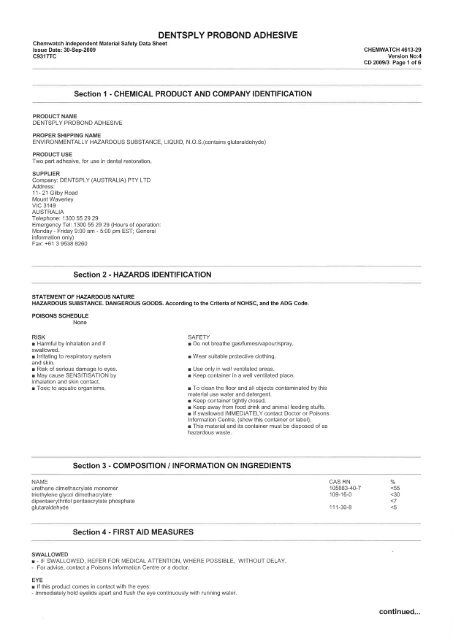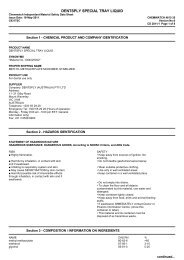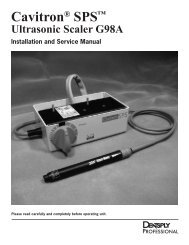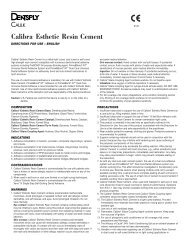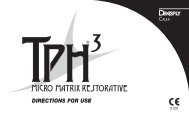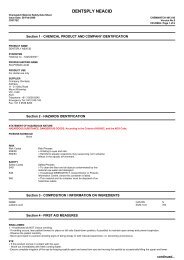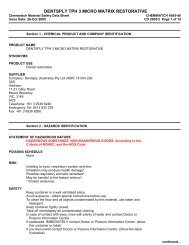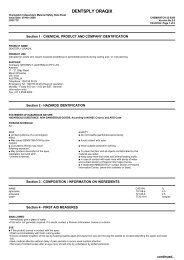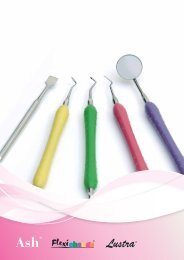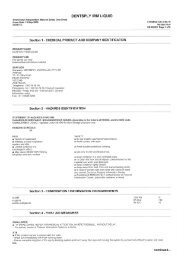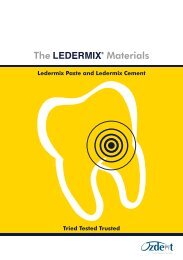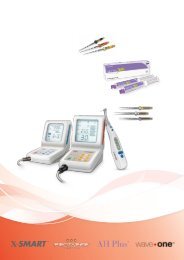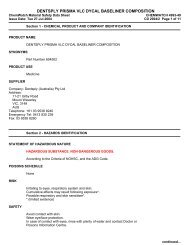105883-40-7
105883-40-7
105883-40-7
You also want an ePaper? Increase the reach of your titles
YUMPU automatically turns print PDFs into web optimized ePapers that Google loves.
DENTSPLY PROBOND ADHESIVE<br />
Chemwatch lndependent Material Safety Data Sheet<br />
lssue Date: 30-Sep-2009 CHEMWATCH 4613-29<br />
C9317TC<br />
Version No:4<br />
CD 2009/3 Page 1 of 6<br />
Section I - CHEMICAL PRODUCT AND COMPANY IDENTIFIGATION<br />
PRODUCT NAME<br />
DENTSPLY PROBOND ADHESIVE<br />
PROPER SHIPPING NAME<br />
ENVIRONMENTALLY HAZARDOUS SUBSTANCE, LlQUlD, N.O.S (contains glutaraldehyde)<br />
PRODUCT USE<br />
Two part adhesive, for use in dental restoration<br />
SUPPLIER<br />
Company: DENTSPLY (AUSTRALIA) PTY LTD<br />
Address:<br />
1 1- 21 Gilby Road<br />
Mount Waverley<br />
vtc 3'149<br />
AUSTRALIA<br />
Telephone: 1300 55 29 29<br />
Emergency Tel: 1300 55 29 29 (Hours of operation:<br />
lvlonday - Friday 9:00 am - 5:00 pm EST; General<br />
information only)<br />
Fax: +61 3 9538 8260<br />
Section 2 - HAZARDS IDENTIFICATION<br />
STATEMENT OF HAZARDOUS NATURE<br />
HAZARDOUS SUBSTANCE. DANGEROUS GOODS. According to the Criteria of NOHSC, and the ADG Code.<br />
POISONS SCHEDULE<br />
None<br />
r Harmful by inhalation and if<br />
swâllowed<br />
I lrritating to respiratory system<br />
and skin<br />
Risk of serious damage to eyes.<br />
r May cause SENSITISATION by<br />
inhalation and skin contact<br />
r Toxic to aquatic organisms<br />
SAFETY<br />
r Do not breathe gas/fumes/vapour/spray<br />
r Wear suitable protective clothing<br />
Use only in well ventilated areas<br />
r Keep container in a well ventilated place<br />
r To clean the floor and all objects contaminated by th¡s<br />
material use water and detergent.<br />
r Keep container tightly closed<br />
r Keep away from food drink and animal feeding stuffs<br />
r lf swallowed l|\4MEDIATELY contact Doctor or Poisons<br />
lnformation Centre (show this contaìner or label)<br />
r This material and its container must be disposed of as<br />
hazardous waste<br />
Section 3 - COMPOSITION / INFORMATION ON INGREDIENTS<br />
NAIVE<br />
urethane dimethacrylate monomer<br />
triethylene glycol dimethacrylate<br />
dipentaerythritol pentaacrylate phosphate<br />
glutaraldehyde<br />
CAS RN<br />
IO<br />
<strong>105883</strong>-<strong>40</strong>-7
DENTSPLY PROBOND ADHESIVE<br />
Chemwatch lndependent Mater¡al Safety Data Sheet<br />
lssue Date: 30-Sep-2009 CHEMWATCH 46l3-29<br />
C9317TC<br />
Version No:4<br />
CD 2009/3 Page 2 ofG<br />
Section 4 - FIRST AID MEASURES<br />
- Ensure complete irrigation of the eye by keeping eyelids apart and away from eye and moving the eyelids by occasionally lifting the upper and lower<br />
lids<br />
SKIN<br />
r lf skin contact occurs:<br />
- lmmediately remove all contaminated clothing, ¡ncluding footwear.<br />
- Flush skin and hair with running water (and soap if available).<br />
INHALED<br />
r - lf fumes or combustion products are inhaled remove from contaminated area<br />
- Lay patient down Keep warm and rested<br />
NOTES TO PHYSICIAN<br />
r for poisons (where specific treatment regime is absent):<br />
BASIC TREATI\4ENT<br />
- Establish a patent airuvay with suction where necessary.<br />
- Watch for signs of respiratory insufficiency and assist ventilatíon as necessary<br />
Treat symptomatically<br />
Section 5 - FIRE FIGHTING MEASURES<br />
EXTINGUISHING MEDIA<br />
r - Foam.<br />
- Dry chemical powder<br />
FIRE FIGHTING<br />
¡ - Alert F¡re Brigade and tell them location and nature of hazard.<br />
- May be violently or explosively reactive<br />
FIRE/EXPLOSION HAZARD<br />
r - Combustible.<br />
- Slight fire hazard when exposed to heat or flame<br />
Combustion products include: carbon dioxide (CO2), nitrogen oxides (NOx), other pyrolysis products typical of burning organic material<br />
lvlay emit poisonous fumes.<br />
May emit corrosive fumes<br />
FIRE INCOMPATIBILITY<br />
I - Avoid contamination with oxidising agents i e. nitrates, oxidising acids, chlorine bleaches, pool chlorine etc as ignition may result<br />
HAZCHEM: ¡32<br />
Personal Protect¡ve Equ¡pment<br />
Gas tight chemical resistant suit<br />
Section 6 - ACCIDENTAL RELEASE MEASURES<br />
MINOR SPILLS<br />
r - Remove all ignition sources.<br />
- Clean up all spills immediately<br />
MAJOR SPILLS<br />
r l\4oderate hazard<br />
- Clear area of personnel and move upwind.<br />
- Alert Fire Brigade and tell them location and nature of hazard.<br />
Personal Protective Equipment advice is contained in Section I of the MSDS.<br />
Section 7 - HANDLING AND STORAGE<br />
PROCEDURE FOR HANDLING<br />
¡ - Most acrylic monomers have low viscositytherefore pouring, material transferand processing of these materials do not necessitate heating.<br />
- Viscous monomers may require heating to facilitate handling To fac¡litate product transfer from original containers, product must be heated to no<br />
more than 60 deg. C. (1<strong>40</strong> F.), for not more than 24 hours.<br />
- DO NOT allow clothing wet with material to stay in contact with skin<br />
- Avoid all personal contact, including inhalation<br />
- Wear protective clothing when risk of exposure occurs<br />
SUITABLE CONTAINER<br />
r - Metal can or drum<br />
cont¡nued...
DENTSPLY PROBOND ADHESIVE<br />
Ghemwatch lndependent Material Safety Data Sheet<br />
lssue Date:30-Sep-2009 CHEMWATCH 4613-29<br />
C9317TC<br />
- Packaging as recommended by manufacturer.<br />
STORAGE INCOMPATIBILITY<br />
r for multifunctional acrylates:<br />
- Avoid exposure to free radical initiators (peroxides, persulfates) , iron, rust, oxidisers, and strong acids and strong bases<br />
- Avo¡d heat, flame, sunlight, X-rays or ultra-violet radiation., halogens<br />
Avoid mixing with alkali metals such as sodium, potassium and lithium<br />
Avoid reaction with<br />
STORAGE REQUIREMENTS<br />
r - Store in original containers<br />
- Keep containers securely sealed<br />
Version No:4<br />
CD 2009/3 Page 3 of 6<br />
Section 7 - HANDLING AND STORAGE<br />
Section I - EXPOSURE CONTROLS / PERSONAL PROTECTION<br />
EXPOSURE CONTROLS<br />
Source<br />
l\ilateriaì<br />
Peak ppm Peak mg/m' Notes<br />
Australia Exposure<br />
Standards<br />
glutaraldehyde<br />
(Glutaraldehyde)<br />
01 041<br />
Sen<br />
The following materials had no OELs on our records<br />
. urethane dimethacrylate monomer:<br />
. triethylene glycol dimethacrylate:<br />
CAS:<strong>105883</strong>- <strong>40</strong>- 7<br />
CAS:'109- 16- 0<br />
PERSONAL PROTECTION<br />
RESPIRATOR<br />
Type ANO Filter of sufficient capacity<br />
EYE<br />
r - Safety glasses w¡th side shields<br />
- Chemical goggles.<br />
HANDS/FEET<br />
r - Wear chemical protective gloves, eg. PVC<br />
- Wear safety footwear or safety gumboots, eg. Rubber<br />
NOTE:<br />
- The material may produce skin sensitisation in predisposed individuals Care must be taken, when removing gloves and other protective equipment, to<br />
avoid all possible skin contact.<br />
- Contaminated leather items, such as shoes, belts and watch-bands should be removed and destroyed<br />
Suitability and durability of glove type is dependent on usage. Factors such as:<br />
- frequency and duration of contact,<br />
- chemical resistance of glove material,<br />
OTHER<br />
r - Overalls.<br />
- P.V C apron<br />
ENGINEERING CONTROLS<br />
r Local exhaust ventilation usually required lf risk of overexposure exists, wear approved respirator<br />
Section I - PHYSICAL AND CHEMICAL PROPERTIES<br />
APPEARANCE<br />
Light yellow liquid with a characteristic odour; does not mix with water<br />
PHYSICAL PROPERTIES<br />
Liquid<br />
Does not mix with water.<br />
Sinks in water.<br />
lvlolecular Weight: Not Applicable<br />
lvlelt¡ng Range (C): Not Available<br />
Solubility in water (g/L): lmmiscible<br />
pH (1% solution): Noi Applicable<br />
Volatile Component (%vol): Not Available<br />
Relative Vapour Density (air=1): Not Available<br />
Lower Explosive Limit (%): Not Available<br />
Autoignltion Temp (C): Not Available<br />
State: Liquid<br />
Boiling Range (C): Not Available<br />
Specific Gravity (water=1): 1.1 approx<br />
pH (as supplied): Not Available<br />
Vapour Pressure (kPa): Not Available<br />
Evaporat¡on Rate: Not Available<br />
Flash Point (C): Not Available<br />
Upper Explosive Limit (%): Not Available<br />
Decomposition Temp (C): Not Available<br />
Viscosity: Not Available<br />
cont¡nued...
DENTSPLY PROBOND ADHESIVE<br />
Chemwatch lndependent Material Safety Data Sheet<br />
lssue Date: 30-Sep-2009 CHEMWATCH 4613-29<br />
C9317TC<br />
Version No:4<br />
CD 2009/3 Page 4 of6<br />
Section 10 - CHEMICAL STABILITY AND REACTIVITY INFORMATION<br />
CONDITIONS CONTRIBUTING TO INSTABILITY<br />
r - Presence of incompatible materials<br />
- Product is considered stable.<br />
- Presence of elevated temperatures.<br />
For incompatible mater¡als - refer to Sect¡on 7 - Handling and Storage<br />
Section l1 - TOXICOLOGICAL INFORMATION<br />
POTENTIAL HEALTH EFFECTS<br />
ACUTE HEALTH EFFECTS<br />
r Risk of serious damage to eyes<br />
r Harmful by inhalation and if swallowed<br />
r lrritating to respiratory system and<br />
skin<br />
CHRONIC HEALTH EFFECTS<br />
r May cause SENSITISATION by inhalation and skin<br />
contact<br />
TOXICITY AND IRRITATION<br />
r Not available. Refer to individual constituents.<br />
URETHANE DII\4ETHACRYLATE MONOMER:<br />
r No significant acute toxicological data identified in literature search.<br />
TRIETHYLENE GLYCOL DIMETHACRYLATE:<br />
r unless otherwise specified data extracted from RTECS - Register of Toxic Effects of Chemical Substances.<br />
TOXICITY<br />
IRRITATION<br />
Oral (rat) LD50: 10837 mg/kg<br />
Nil Reported<br />
Oral (mouse) LD50: 10750 mg/kg<br />
r Contact allergies quickly manifest themselves as contact eczema, more rarely as urt¡caria or Quincke's oedema. The pathogenesis of contact eczema<br />
involves a cell-mediated (T lymphocytes) immune reaction of the delayed type.<br />
Asthma-like symptoms may continue for months or even years after exposure to the material ceases This may be due to a non-allergenic condit¡on known<br />
as reactive airways dysfunction syndrome (RADS) which can occurfoliowing exposure to high levels of highly irritating compound.<br />
GLUTARALDEHYDE:<br />
r unless otherwise specifìed data extracted from RTECS - Registerof Toxic Effects of Chemical Substances.<br />
TOXICITY<br />
Oral (rat) LD50: '134 mg/kg<br />
lnhalation (rat) LC50: 480 mg/m'/4h<br />
Dermal (rabbit) LD50: <strong>40</strong>3 mg/kg<br />
IRRITATION<br />
Skin (human): 6 mg/3d- int- SEVERE<br />
Skin (rabbit): 13 mg open- N4ild<br />
Skin (rabbit): 2 mgl24h- SEVERE<br />
Eye (rabbit): 1 mg- SEVERE<br />
Eye (rabbit): O 25mgl24h- SEVERE<br />
r Asthma-like symptoms may continue for months or even years after exposure to the material ceases This may be due to a non-allergenic condition<br />
known as reactive airways dysfunction syndrome (RADS) which can occur following exposure to high levels of highly irritating compound<br />
The material may produce severe skin irritation after prolonged or repeated exposure, and may produce a contact dermatitis (nonallergic) Th¡s form<br />
of dermatitis is often characterised by skin redness (erythema) thickening of the epidermis<br />
Animal studies indicate that the oral LD50 of glutaraldehyde in rats, mice and guinea pigs, is approximately 50-250 mg/kg, and that the acute dermal<br />
toxicity in rabbits, rats and mice is approximately 1000-4500 mg/kg, with skin absorption at high concentrat¡ons Glutaraldehyde has a high acute<br />
inhalational toxicity in rats and mice and lung damage has been reported<br />
SENSITISER<br />
triethylene glycol<br />
dimethacrylate<br />
Australia Final Report on Hazard<br />
Classification of Common Skin Sensitisers<br />
Recommended for<br />
Hazard Classification<br />
(R43)<br />
No<br />
Section l2 - ECOLOGICAL INFORMATION<br />
Toxic to aquatic organisms<br />
This material and its container must be disposed of as hazardous waste<br />
Ecotoxicity<br />
lngredient<br />
Dentsply Probond Adhesive<br />
urethane dimethacrylate monomer<br />
triethylene glycol dimethacrylate<br />
glutaraldehyde<br />
Persistence: Persistence: Bioaccumulat Mobility<br />
Water/Soil Air ion<br />
No data<br />
No data<br />
No data<br />
No data<br />
continued...
DENTSPLY PROBOND ADHESIVE<br />
Chemwatch lndependent Material Safety Data Sheet<br />
lssue Date: 30-Sep-2009 CHEMWATCH 4613-29<br />
C9317TC<br />
Version No:4<br />
CD 2009/3 Page 5 of6<br />
Section 13 - DISPOSAL CONSIDERATIONS<br />
r - Containers may still present a chemical hazatdl danget when empt<br />
- Return to supplier for reuse/ recycling if poss¡ble<br />
Legislation addressing waste disposal requirements may differ by country, state and/ or territory Each user must refer to laws operating in their<br />
area.<br />
- DO NOT allow wash water from cleaning or process equipment to enter drains.<br />
- lt may be necessary to collect allwash water for treatment before disposal<br />
- Recycle wherever possible or consult manufacturer for recycling options<br />
- Consult State Land Waste Authority for disposal<br />
Section l4 - TRANSPORTATION INFORMATION<br />
t Environmentally Hazardous Substances meeting the descriptions of UN 3077 or UN 3082<br />
are not subject to this Code when transpoñed by road or rail ín;<br />
(a) packagings;<br />
(b) lBCs; or<br />
(c) any other receptacle not exceeding 500 kg(L).<br />
- Australian Special Provisions (SP AU01) - ADG Code 7th Ed<br />
Labels Required: MISCELLANEOUS<br />
HMCHEM: o32 (ADG7)<br />
ADGT:<br />
Class or division:<br />
UN No.:<br />
Special provisions:<br />
Notes:<br />
Portable tanks and bulk<br />
-14<br />
conta¡ners -<br />
lnstructions:<br />
Packagings and lBCs -<br />
Pack¡ng instruction:<br />
P001, lBC03, LP01<br />
provtstons:<br />
Shipping Name:ENVIRONI\4ENTALLY HAZARDOUS SUBSTANCE, L|QUlD, N O S<br />
(conta¡ns glutaraldehyde)<br />
Land Transport UNDG:<br />
Class or div¡sion: 9<br />
Subsidiary risk:<br />
UN No: 3082<br />
UN packing group:<br />
Shipping Name:ENVIRONMENTALLY HAZARDOUS SUBSTANCE, LlQUlD, N O S<br />
(contains glutaraldehyde)<br />
Maritime Transport IMDG:<br />
IMDG Class:<br />
UN Number:<br />
EMS Number:<br />
a<br />
3082<br />
179,274,331,33s<br />
None<br />
o<br />
3082<br />
F-A, S- F<br />
5 L<br />
Subsidiary risk:<br />
UN packing group:<br />
Packing lnstructions:<br />
Limited quantities:<br />
Portable tanks and bulk<br />
containers - Special<br />
provrsrons:<br />
Packagings and lBCs -<br />
Special packing<br />
A¡r Transport IATA:<br />
ICAO/IATA Class: 9 ICAO/IATA Subrisk<br />
UN/ID Number: 3082 Packing Group:<br />
Special provisions: 497<br />
Sh¡pping Name: ENVIRONMENTALLY HMARDOUS SUBSTANCE, LlQUlD,<br />
N O S. -(CONTAINS GLUTARALDEHYDE)<br />
Limited Quantities:<br />
Shipping Name: ENVIRONMENTALLY HAZARDOUS SUBSTANCE, LlQUlD,<br />
N.O S (contains glutaraldehyde)<br />
IMDG Subrisk:<br />
Packing Group:<br />
Special provisions:<br />
l\4arine Pollutant:<br />
None<br />
ilt<br />
None<br />
5L<br />
TP1, TP29<br />
PP1<br />
None<br />
ilt<br />
None<br />
ilt<br />
None<br />
ilt<br />
274 909 944<br />
Not Determined<br />
Section l5 - REGULATORY INFORMATION<br />
POISONS SCHEDULE: None<br />
REGULATIONS<br />
Regulations for ingredients<br />
triethylene glycol d¡methacrylate (CAS: 109-16-0) is found on the following regulatory l¡sts;<br />
Production Volume List","OECD Representative List of High Production Volume (HPV) Chemicals"<br />
cont¡nued...
DENTSPLY PROBOND ADHESIVE<br />
Chemwatch lndependent Material Safety Data Sheet<br />
lssue Date: 30-Sep-2009<br />
c931 7TC<br />
CHEMWATCH 46'13-29<br />
Version No:4<br />
CD 2009/3 Page 6 of 6<br />
Section 15 - REGULATORY INFORMATION<br />
glutaraldehyde (CAS: 111-30-8) ¡s found on the following regulatory lists;<br />
and Poisons (SUSDP) - Schedule 6","lMO IBC Code Chapter 17: Summar of minimum requirements",'lMO MARPOL 73178 (Annex ll) - List of Noxious Liquid Substances Carried in Bul<br />
L¡st of High Production Volume (HPV) Chemicals"<br />
No data for Dentsply Probond Adhesive (CW: 4613-29)<br />
No data for urethane d¡methacrylate monomer (CAS: , <strong>105883</strong>-<strong>40</strong>-7)<br />
Section 16 - OTHER INFORMATION<br />
Denmark Advisory list for selfclassification of dangerous substances<br />
Substance<br />
CAS Suggested codes<br />
triethylene glycol dimethacrylate<br />
109- 16- 0 R43 N; R51/53<br />
r Class¡fication of the preparation and its individual components has drawn on official and authoritative sources as well as independent review by<br />
the Chemwatch Classification committee using available l¡terature references.<br />
A list of reference resources used to assist the committee may be found at:<br />
www chemwatch.neUreferences.<br />
r The (lVl)SDS is a Hazard Communication tool and should be used to assist in the Risk Assessment Many factors determine whether the reported Hazards<br />
are Risks in the workplace or other sett¡ngs.<br />
This document is copyright. Apañ from any fair dealing for the purposes of private study, research, review or<br />
criticism, as permitted under the Copyright Act, no pan may be reproduced by any process without written<br />
permission from CHEMWATCH. TEL (+61 3) 9572 4700<br />
lssue Date: 30-Sep-2009<br />
Print Date: 30-Sep-2009<br />
Th¡s is lhe end of the MSDS
DENTSPLY PROBOND PRIMER<br />
Ghemwatch lndependent Material Safety Data Sheet<br />
lssue Date: 8-Oct-2009 CHEMWATCH 4613-30<br />
C93I7TC<br />
Version No:5<br />
CD 2009/3 Page 1 of6<br />
Section I - CHEMICAL PRODUCT AND COMPANY IDENTIFICATION<br />
PRODUCT NAME<br />
DENTSPLY PROBOND PRII\¡ER<br />
PROPERSHIPPING NAME<br />
FLAMMABLE L|QUlD, N O S (contains acetone and ethanol)<br />
PRODUCT USE<br />
Two part adhesive, for use in dental restorations<br />
SUPPLIER<br />
Company: DENTSPLY (AUSTRALIA) PTY LTD<br />
Address:<br />
1 1- 21 Gilby Road<br />
Mount Waverley<br />
vtc 3149<br />
AUSTRALIA<br />
Telephone: '1300 55 29 29<br />
Emergency Tel: 1300 55 29 29 (Hours of operation:<br />
Monday - Friday 9:00 am - 5:00 pm EST; General<br />
information only)<br />
Fax: +61 3 9538 8260<br />
Section 2 - HAZARDS IDENTIFICATION<br />
STATEMENT OF HAZARDOUS NATURE<br />
HAZARDOUS SUBSTANCE. DANGEROUS GOODS. According to the Criteria of NOHSC, and the ADG Code.<br />
POISONS SCHEDULE<br />
None<br />
RSK<br />
Highly flammable<br />
lrritat¡ng to eyes.<br />
r HARMFUL- May cause lung damage if<br />
swallowed.<br />
I Repeated exposure may cause skin<br />
dryness and cracking<br />
r Vapours may cause drowsiness and<br />
dizziness.<br />
SAFETY<br />
I Keep away from sources of ignition No smoking.<br />
r Do not breathe gas/fumes/vapour/spray.<br />
r Avoid contact with eyes<br />
I Wear suitable protective clothing<br />
r Use only in well ventilated areas<br />
r Keep container in a well ventilated place<br />
r Do not empty into drains<br />
r To clean the floor and all objects contaminated by this<br />
material use water.<br />
r Keep container tightly closed.<br />
r Keep away from food drink and animal feeding stuffs<br />
r ln case of contact with eyes rinse with plenty of water<br />
and contact Doctor or Poisons lnformation Centre.<br />
¡ lf swallowed IMMEDIATELY contact Doctor or Poisons<br />
lnformation Centre (show this container or label).<br />
r This material and its container must be disposed of as<br />
hazardous waste<br />
Section 3 - COMPOSITION / INFORMATION ON INGREDIENTS<br />
NAME<br />
acetone<br />
ethanol<br />
dipentaerythritol pentaacrylate phosphate<br />
CAS RN<br />
67-64-1<br />
64-17 -5<br />
%<br />
DENTSPLY PROBOND PRIMER<br />
Chemwatch lndependent Mater¡al Safety Data Sheet<br />
lssue Date:8-Ocþ2009 CHEMWATCH 4613-30<br />
C9317TC<br />
Version No:5<br />
CD 2009/3 Page 2 of 6<br />
Section 4 - FIRST AID MEASURES<br />
EYE<br />
r lf this product comes in contact with the eyes:<br />
- lmmediately hold eyelids apart and flush the eye continuously w¡th running water.<br />
- Ensure complete irrigation of the eye by keeping eyelids apart and away from eye and moving the eyelids by occas¡onally lifting the upper and lower<br />
lids<br />
SKIN<br />
I lf skin or hair contact occurs:<br />
- Flush skin and hair with running water (and soap if available)<br />
- Seek medical attention in event of irritation.<br />
INHALED<br />
r - lf fumes or combustion products are inhaled remove from contaminated area<br />
- Lay patient down Keep warm and rested.<br />
NOTES TO PHYSICIAN<br />
r Any material aspirated during vómiting may produce lung injury. Therefore emesis should not be induced mechanically or pharmacologically.<br />
For acute or short term repeated exposures to acetone:<br />
- Symptoms of acetone exposure approximate ethanol intoxication.<br />
- About 20% is expired by the lungs and the rest is metabolised. Alveolar air half-life is about 4 hours following two hour inhalation at levels near<br />
the Exposure Standard; in overdose, saturable metabolism and limited clearance, prolong the elimination half-life to 25-30 hours<br />
For acute or short term repeated exposures to ethanol:<br />
- Acute ingestion in non-tolerant patients usually responds to supportive care with special attention to prevent¡on of aspiration, replacement of<br />
fluid and correction of nutritional deficiencies (magnesium, thiamine pyridoxine, Vitamins C and K).<br />
- Give 50% dextrose (50-100 ml) ¡V to obtunded patients following blood draw for glucose determination<br />
Section 5 - FIRE FIGHTING MEASURES<br />
EXTINGUISHING MEDIA<br />
r - Alcohol stable foam<br />
- Dry chemical powder.<br />
FIRE FIGHTING<br />
r - Alert Fire Brigade and tell them location and nature of hazard.<br />
- May be violently or explosively reactive<br />
FIRE/EXPLOSION HAZARD<br />
r - Liquid and vapour are highly flammable<br />
- Severe fire haza¡d when exposed to heat, flame and/or oxidisers.<br />
Combustion products include: carbon dioxide (C02), carbon monoxide (CO), other pyrolysis products typical of burning organic material.<br />
lVay emit poìsonous fumes.<br />
FIRE INCOMPATIBILITY<br />
r - Avoid contamination with oxidising agents ie nitrates, oxidising acids, chlorine bleaches, pool chlorine etc. as ignit¡on may result<br />
HAZCHEM: e3YE<br />
PERSONAL PROTECTION<br />
Glasses:<br />
Full face- shield.<br />
Gloves:<br />
PVC chemical res¡stant type<br />
Respirator:<br />
Type AXNO Filter of sufficient capac¡ty<br />
Section 6 - AGGIDENTAL RELEASE MEASURES<br />
MINOR SPILLS<br />
r - Remove all ignition sources<br />
- Clean up all spills immediately.<br />
MAJOR SPILLS<br />
r - Clear area of personnel and move upwind.<br />
- Alert Fire Brigade and tell them location and nature of hazard.<br />
Personal Protective Equipment advice is contained in Section I of the MSDS.<br />
cont¡nued...
DENTSPLY PROBOND PRIMER<br />
Chemwatch lndependent Mater¡al Safety Data Sheet<br />
lssue Date: 8-Oct-2009<br />
c931 7TC<br />
CHEMWATCH 4613-30<br />
Version No:5<br />
CD 2009/3 Page 3 of 6<br />
Section 7 - HANDLING AND STORAGE<br />
PROCEDURE FOR HANDLING<br />
r - Avoid all personal contact, including inhalation.<br />
- Wear protective clothing when risk of exposure occurs.<br />
- DO NOT allow clothing wet with material to stay ¡n contact with skin.<br />
SUITABLE CONTAINER<br />
r - Packing as supplied by manufacturer.<br />
- Plastic containers may only be used if approved for flammable liquid<br />
- For low viscosity materials (i) : Drums and jerry cans must be of the non-removable head type. (ii) : Where a can is to be used as an inner package,<br />
the can must have a screwed enclosure.<br />
- For materials with a viscosity of at least 2680 cSt (23 deg. C).<br />
STORAGE INCOMPATIBILITY<br />
I - Avoid reaction with oxidising agents.<br />
STORAGE REQUIREMENTS<br />
r - Store in original containers in approved flame-proof area<br />
- No smoking, naked lights, heat or ignition sources<br />
- Store below 38 deg. C.<br />
Section I - EXPOSURE CONTROLS / PERSONAL PROTECTION<br />
EXPOSURE CONTROLS<br />
Source<br />
Material<br />
TWA ppm<br />
TWA mg/m'<br />
STEL ppm<br />
STEL mg/m3<br />
Australia Exposure<br />
Standards<br />
Australia Exposure<br />
Standards<br />
acetone (Acetone)<br />
ethanol (Ethyl alcohol)<br />
500<br />
1 000<br />
1185<br />
1 880<br />
1 000<br />
2375<br />
PERSONAL PROTECTION<br />
RESPIRATOR<br />
Type AXNO Filter of sufficient capacity<br />
EYE<br />
r - Chemical goggles.<br />
- Full face shield may be requ¡red for supplementary but never for primary protection of eyes<br />
HANDS/FEET<br />
I - Wear chemical protective gloves, eg PVC<br />
- Wear safety footwear or safety gumboots, eg Rubber.<br />
OTHER<br />
r - Overalls.<br />
- PVC Apron<br />
¡ None under normal operating conditions<br />
ENGINEERING CONTROLS<br />
I Local exhaust ventilation usually required, lf risk of overexposure exists, wear approved respirator<br />
Section I - PHYSICAL AND GHEMICAL PROPERTIES<br />
APPEARANCE<br />
Water white, highly flammable liquid w¡th a characteristic odour; does not mix with<br />
water<br />
PHYSICAL PROPERTIES<br />
Liquid<br />
Mixes with water<br />
Molecular Weight: Not Applicable<br />
Melting Range (C): Not Available<br />
Solubility in water (g/L): Miscible<br />
pH (1% solution): Not Available<br />
Volat¡le Component (%vol): Not Available<br />
Relative Vapour Density (air='1): Not Available<br />
Boiling Range (C): 56<br />
Specific Gravity (water=1): 0.8 approx<br />
pH (as supplied): Not Available<br />
Vapour Pressure (kPa): Not Available<br />
Evaporation Rate: Not Available<br />
Flash Point (C):
DENTSPLY PROBOND PRIMER<br />
Chemwatch lndependent Material Safety Data Sheet<br />
lssue Date: 8-Oct-2009 CHEMWATCH 4613-30<br />
C9317TC<br />
Lower Explosive Limit (%): 2.5 Upper Explosive Limit (%): 13<br />
Autoignition Temp (C): Not Available<br />
State: Liquid<br />
Version No:S<br />
CD 2009/3 Page 4 of 6<br />
Section 9 - PHYSICAL AND CHEMICAL PROPERTIES<br />
Decomposition Temp (C): Not Available<br />
Viscosity: Not Available<br />
Section 10 - CHEMICAL STABILITY AND REACTIVITY INFORMATION<br />
CONDITIONS CONTRIBUTING TO INSTABILITY<br />
r - Presence of incompatible materials.<br />
- Product is considered stable.<br />
For incompatible materials - refer to Section 7 - Handling and Storage<br />
Section 11 - TOXICOLOGICAL INFORMATION<br />
POTENTIAL HEALTH EFFECTS<br />
ACUTE HEALTH EFFECTS<br />
I lrritating to eyes.<br />
r HARMFUL- l\rlay cause lung damage if<br />
swallowed.<br />
r Vapours may cause dizziness or<br />
suffocation.<br />
r Vapours may cause drowsiness and<br />
diziness.<br />
CHRONIC HEALTH EFFECTS<br />
I Repeated exposure may cause sk¡n dryness and<br />
cracking<br />
TOXICITY AND IRRITATION<br />
I Not available Refer to individual constituents<br />
ACETONE:<br />
r unless otherwise specified data exiracted from RTECS - Register of Toxic Effects of Chemical Substances<br />
TOXICITY<br />
IRRITATION<br />
Oral (man) TDLo: 2857 mg/kg<br />
Eye (human): 500 ppm - lrritant<br />
Oral (rat) LD50: 5800 mg/kg<br />
Eye (rabbit): 3 95 mg - SEVERE<br />
lnhalation (human) TCLo: 500 ppm<br />
Eye (rabbit): 2omgl24hr - Moderate<br />
lnhalation (man)TCLo: 12000 ppm/4 hr<br />
Skin (rabbit):395m9 (open) - Mild<br />
lnhalation (man) TCLo: 10 mg/m3/6 hr<br />
Skin (rabbit): 500 mg/24hr - M¡ld<br />
lnhalation (rat) LC50: 50100 mg/m'/8 hr<br />
Dermal (rabbit) LD50: 20000 mg/kg<br />
I The materìal may cause skin irritation after prolonged or repeated exposure and may produce a contact dermatitis (nonallergic) This form of<br />
dermatitis is often characterised by skin redness (erythema) and swelling epidermis<br />
for acetone:<br />
The acute toxicity of acetone is low Acetone is not a skin irritant or sensitiser but is a defatting agent to the skin<br />
ETHANOL:<br />
I unless otherwise specifìed data extracted from RTECS - Registerof Toxic Effects of Chemical Substances<br />
TOXICITY<br />
IRRITATION<br />
Oral (rat) LD50: 7060 mg/kg<br />
Skin (rabbit):20 mgl24hr- lvloderate<br />
Oral (human) LDLo: 1<strong>40</strong>0 mg/kg<br />
Skin (rabbit):<strong>40</strong>O mg (open)- Mild<br />
Oral (man) TDLo: 50 mg/kg<br />
Eye (rabbit):l00mgl24hr- Moderate<br />
Oral (man) TDLo: 1.<strong>40</strong> mg/kg<br />
Eye (rabbit): 500 mg SEVERE<br />
Oral (woman) TDLo: 256 mg/kg/12 wks<br />
lnhalation (rat) LC50: 20, 000 ppm/10h<br />
lnhalation (rat) LC50: 6<strong>40</strong>00 ppm/4h<br />
¡ The material may cause skin irritation after prolonged or repeated exposure and may produce a contact dermatitis (nonallergic) This form of<br />
dermatitis is often characterised by skin redness (erythema) and swelling the epidermis<br />
CARGINOGEN<br />
Ethanol in alcoholic<br />
beverages<br />
lnternat¡onal Agency for Research on Cancer<br />
(IARC) Carcinogens<br />
Group<br />
Section 12 - ECOLOGICAL INFORMATION<br />
This material and its conta¡ner must be disposed of as hazardous waste<br />
Ecotox¡c¡ty<br />
lngredient Persistence: Persistencei Bioaccumulat Mobility<br />
Water/Soil Air ion<br />
Dentsply Probond Primer<br />
acetone<br />
No data<br />
No data<br />
continued...
DENTSPLY PROBOND PRIMER<br />
Chemwatch lndependent Material Safety Data Sheet<br />
lssue Date: 8-Ocf2009<br />
c931 7TC<br />
CHEMWATCH 4613.30<br />
Version No:5<br />
CD 2009/3 Page 5 of 6<br />
Section 12 - ECOLOGICAL INFORMATION<br />
ethanol<br />
No data<br />
I - Consult manufacturer for<br />
- Consult State Land Waste<br />
Section 13 - DISPOSAL CONSIDERATIONS<br />
recycling options and recycle where possible<br />
l\4anagement Author¡ty for disposal<br />
Section I4 - TRANSPORTATION INFORMATION<br />
Labels Required: FLAMMABLE LIQUID<br />
HAZCHEI\tf : o3YE (ADG7)<br />
ADGT:<br />
Class or division:<br />
UNNo:<br />
Special provisions:<br />
Notes:<br />
Portable tanks and bulk<br />
containers -<br />
lnstructions:<br />
Packagings and lBCs -<br />
Packing instruction:<br />
Shipping Name:FLAMIVIABLE L¡QUlD, N O.S (contains acetone and ethanol)<br />
Land Transport UNDG:<br />
Class or division:<br />
UNNo:<br />
Shipping Name:FLAI\4MABLE LlQUlD,<br />
3<br />
1 993<br />
274<br />
None<br />
T7<br />
P001, tBC02<br />
1 993<br />
N O S (contains acetone and ethanol)<br />
Subsidiary risk:<br />
UN packing group:<br />
Packing lnstructions:<br />
Limited quantities:<br />
Portable tanks and bulk<br />
containers - Special<br />
provrsrons:<br />
Packagings and lBCs -<br />
Special packing<br />
provrsrons:<br />
Subsid¡ary risk:<br />
UN packing group:<br />
None<br />
il<br />
None<br />
1L<br />
TP1, TP8, TP28<br />
None<br />
None<br />
il<br />
A¡r Transport IATA:<br />
ICAO/IATA Class:<br />
3<br />
UN/lD Number:<br />
1 993<br />
Spec¡al provisions:<br />
A3 A1 48<br />
Shipping Name: FLAMMABLE L|QUlD, N O S, .(CONTAINS ACETONE<br />
AND ETHANOL)<br />
Maritime Transport IMDG:<br />
IMDG Class:<br />
UN Number:<br />
EIVIS Number:<br />
Limited Quantitiesi<br />
3<br />
1 993<br />
F-E,S-E<br />
1L<br />
Shipping Name: FLAMMABLE L|QUlD, N O S.(contains acetone<br />
and ethanol)<br />
ICAO/IATA Subrisk:<br />
Packing Group:<br />
IMDG Subrisk:<br />
Packing Group:<br />
Special provisions<br />
Marine Pollutant:<br />
None<br />
il<br />
None<br />
il<br />
274 330 944<br />
Not Determined<br />
Section 15 - REGULATORY INFORMATION<br />
POISONS SCHEDULE: None<br />
REGULATIONS<br />
Regulations for ingredients<br />
acetone (CAS: 67-64-1) is found on the following regulatory lists;<br />
ethanol (CAS: 64-17-5) is found on the following regulatory lists;<br />
No data for Dentsply Probond Primer (CW: 4613-30)<br />
cont¡nued...
DENTSPLY PROBOND PRIMER<br />
Chemwatch lndependent Material Safety Data Sheet<br />
lssue Dale: 8-Oct-2009 CHEMWATCH 4613-30<br />
C93I7TC<br />
Version Nor5<br />
CD 2009/3 Page 6of6<br />
Section 15 - REGULATORY INFORMATION<br />
Section 16 - OTHER INFORMATION


